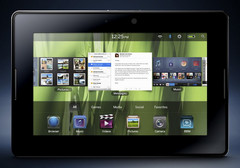Research in Motion (RIM) entered the tablet bandwagon recently with its BlackBerry PlayBook tablet. The PlayBook was one of the most awaited devices in the tablet category because of the lineage it comes from. And just recently, Electronista got a chance to explore the tablet hands-on at the CES and tell us all about it.
What RIM has on show at the CES is the near-production version form and is quite impressive. The BlackBerry Tablet OS debuts itself in the PlayBook and is said to be a sibling of the BlackBerry 6 OS although with improvisations for the touch capability that the tablet employs. The OS features trays to sort apps and a unique window system for multitasking wherein you can always switch to an app or swipe it up to close it right from the home screen. The interface also enjoys multi-touch gestures and is easy-to-navigate with the good responsiveness. Apart from all this, the bezel also lets you control many features on the OS. Take for example; a swipe from the bottom up brings you to the home screen and task switching. Swiping from the top down will bring a contextual menu, and swiping from either the left or the right brings an alternate multitasking-only view that fills up the screen totally.
Talking of the hardware, the BlackBerry PlayBook is powered by a 1GHz dual-core processor and 1GB of memory. A 7-inch, 1024 x 600 pixel LCD multi-touch capacitive screen does good duty on the device which has 3G, 4G, Wi-Fi 802.11 a/b/g/n and Bluetooth 2.1+EDR connectivity options. What’s more, you also get a 3MP front-facing and a 5MP rear-facing HD camera standard fitted for high-quality video conferencing and some snaps here and there. The display also supports playback for full HD (1080p) video and H.264, MPEG4, WMV HDMI video formats are supported. Micro USB and Micro HDMI ports are standard and so is built-in support for Adobe Flash 10.1 and HTML5. With all these specs, Electronista found performance to be almost unaffected all the time however demanding the apps be or even if there are multiple apps open.
Talking of the apps in particular, the built-in media players are reminiscent of those found in BlackBerry phones but are a bit more pleasurable to the eye and do a good job at playing back audio and video. The WebKit based browser is fast too but Flash animations are a bit of a downer here losing out on smoothness. You also get a simple camera app for both cameras but it scores well on ease-of-use and is quick to load.
The tablet, weighing 0.9 lbs and measuring 5.1x7.6x0.4 inches has been found to be well-built and has a small form factor. Although small in size for a tablet, the PlayBook is easy to carry and is good for e-reading. A rubberized back texture also helps you to hold the tablet firmly and avoid it from slipping from your hands. However, one issue with the PlayBook is BBM and e-mail support; you can’t use these services directly from the tablet unless you tether it with a BlackBerry phone. This can prove to be a serious limitation for the tablet compared to others in the competition, but BlackBerry has a reason for that too-security policies. The sleek, all-black BlackBerry PlayBook will start selling from March this year as we have reported earlier, but there’s no confirmation on pricing. The BlackBerry Tablet OS and the hardware itself are actually impressive, but it will be seen whether if it actually is enough to combat the competition.




